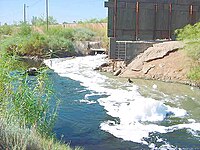
Photo from wikipedia
The results of monitoring of the climatic and natural conditions of the semidesert in the Dzhanybek station of the Institute of Forest Science of the Russian Academy of Sciences (IFS… Click to show full abstract
The results of monitoring of the climatic and natural conditions of the semidesert in the Dzhanybek station of the Institute of Forest Science of the Russian Academy of Sciences (IFS RAS) in the northern Caspian region are presented. Monitoring studies have been conducted since the middle of the past century. The goal of the observations was to determine the implications of climate change for the habitat, profile, and state of the animated nature of the ecosystem components. In the course of the process, the station’s team observed an increase in the average annual air temperature by 2.2°C and the periodicity in the territory wetness caused by variations in the amount of precipitates. Moreover, in the period of increased wetness from 1980 to 1994, the ground water and water body levels increased, herbaceous communities and cereal crops became more yielding, and wild hoofed animals (saigas) proliferated as well. In the period of drought from 1995 to 2009, the spring melt water runoff attenuated, water bodies shoaled and dried, and dry spells repeated from year to year, which negatively affected the development of the ecosystem components. On the whole, the climate changes have not disturbed the dynamic balanced state of the natural ecosystems (e.g., yield of virgin land phytocenoses, wild animal stock); however, long dry spells have irreversibly aggravated the state of man-made forests and even caused their extinction and long-term cereal crop failures on zonal soils, which has led to unstable agricultural product outputs. The research results reveal the need to switch to adaptive fine-contour or focal farming suited most fitted for the climatic and natural condition of the region.
Journal Title: Arid Ecosystems
Year Published: 2018
Link to full text (if available)
Share on Social Media: Sign Up to like & get
recommendations!